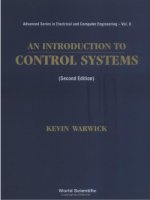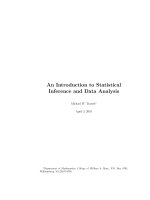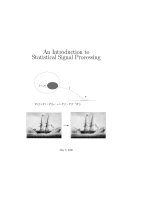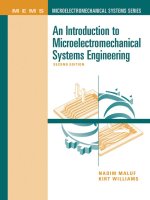An introduction to statistical signal processing
Bạn đang xem bản rút gọn của tài liệu. Xem và tải ngay bản đầy đủ của tài liệu tại đây (2.08 MB, 560 trang )
An Introduction to
Statistical Signal Processing
Pr(f ∈ F ) = P ({ω : ω ∈ F }) = P (f
−1
(F ))
f
−1
(F )
f
F
✲
November 22, 2003
i
ii
An Introduction to
Statistical Signal Processing
Robert M. Gray
and
Lee D. Davisson
Information Systems Laboratory
Department of Electrical Engineering
Stanford University
and
Department of Electrical Engineering and Computer Science
University of Maryland
iii
iv
c
2003 by Cambridge University Press
v
to our Families
vi
Contents
Preface page xii
Glossary xvii
1 Introduction 1
2 Probability 12
2.1 Introduction 12
2.2 Spinning Pointers and Flipping Coins 16
2.3 Probability Spaces 27
2.3.1 Sample Spaces 32
2.3.2 Event Spaces 36
2.3.3 Probability Measures 49
2.4 Discrete Probability Spaces 53
2.5 Continuous Probability Spaces 64
2.6 Independence 81
2.7 Elementary Conditional Probability 82
2.8 Problems 86
3 Random Objects 96
3.1 Introduction 96
3.1.1 Random Variables 96
3.1.2 Random Vectors 101
3.1.3 Random Processes 105
3.2 Random Variables 109
3.3 Distributions of Random Variables 119
3.3.1 Distributions 119
3.3.2 Mixture Distributions 124
vii
viii Contents
3.3.3 Derived Distributions 127
3.4 Random Vectors and Random Processes 132
3.5 Distributions of Random Vectors 135
3.5.1 Multidimensional Events 136
3.5.2 Multidimensional Probability Functions 137
3.5.3 Consistency of Joint and Marginal Distri-
butions 139
3.6 Independent Random Variables 146
3.7 Conditional Distributions 149
3.7.1 Discrete Conditional Distributions 150
3.7.2 Continuous Conditional Distributions 152
3.8 Statistical Detection and Classification 155
3.9 Additive Noise 158
3.10 Binary Detection in Gaussian Noise 167
3.11 Statistical Estimation 168
3.12 Characteristic Functions 170
3.13 Gaussian Random Vectors 176
3.14 Simple Random Processes 178
3.15 Directly Given Random Processes 182
3.15.1 The Kolmogorov Extension Theorem 182
3.15.2 IID Random Processes 182
3.15.3 Gaussian Random Processes 183
3.16 Discrete Time Markov Processes 184
3.16.1 A Binary Markov Process 184
3.16.2 The Binomial Counting Process 187
3.16.3 Discrete Random Walk 191
3.16.4 The Discrete Time Wiener Process 192
3.16.5 Hidden Markov Models 194
3.17 Nonelementary Conditional Probability 194
3.18 Problems 196
4 Expectation and Averages 213
4.1 Averages 213
4.2 Expectation 217
4.3 Functions of Random Variables 221
4.4 Functions of Several Random Variables 228
4.5 Properties of Expectation 229
Contents ix
4.6 Examples 232
4.6.1 Correlation 232
4.6.2 Covariance 235
4.6.3 Covariance Matrices 236
4.6.4 Multivariable Characteristic Functions 237
4.6.5 Differential Entropy of a Gaussian Vector 240
4.7 Conditional Expectation 241
4.8 Jointly Gaussian Vectors 245
4.9 Expectation as Estimation 248
4.10 Implications for Linear Estimation 256
4.11 Correlation and Linear Estimation 258
4.12 Correlation and Covariance Functions 267
4.13 The Central Limit Theorem 270
4.14 Sample Averages 274
4.15 Convergence of Random Variables 276
4.16 Weak Law of Large Numbers 284
4.17 Strong Law of Large Numbers 287
4.18 Stationarity 292
4.19 Asymptotically Uncorrelated Processes 298
4.20 Problems 302
5 Second-Order Theory 322
5.1 Linear Filtering of Random Processes 324
5.2 Linear Systems I/O Relations 326
5.3 Power Spectral Densities 333
5.4 Linearly Filtered Uncorrelated Processes 335
5.5 Linear Modulation 343
5.6 White Noise 346
5.6.1 Low Pass and Narrow Band Noise 351
5.7 Time-Averages 351
5.8 Mean Square Calculus 355
5.8.1 Mean Square Convergence Revisited 356
5.8.2 Integrating Random Processes 363
5.8.3 Linear Filtering 367
5.8.4 Differentiating Random Processes 368
5.8.5 Fourier Series 373
5.8.6 Sampling 377
x Contents
5.8.7 Karhunen-Loueve Expansion 382
5.9 Linear Estimation and Filtering 387
5.9.1 Discrete Time 388
5.9.2 Continuous Time 403
5.10 Problems 407
6 A Menagerie of Processes 424
6.1 Discrete Time Linear Models 425
6.2 Sums of IID Random Variables 430
6.3 Independent Stationary Increment Processes 432
6.4 Second-Order Moments of ISI Processes 436
6.5 Specification of Continuous Time ISI Processes 438
6.6 Moving-Average and Autoregressive Processes 441
6.7 The Discrete Time Gauss-Markov Process 443
6.8 Gaussian Random Processes 444
6.9 The Poisson Counting Process 445
6.10 Compound Processes 449
6.11 Composite Random Processes 451
6.12 Exponential Modulation 452
6.13 Thermal Noise 458
6.14 Ergodicity 461
6.15 Random Fields 466
6.16 Problems 467
A Preliminaries 479
A.1 Set Theory 479
A.2 Examples of Proofs 489
A.3 Mappings and Functions 492
A.4 Linear Algebra 493
A.5 Linear System Fundamentals 497
A.6 Problems 503
B Sums and Integrals 508
B.1 Summation 508
B.2 Double Sums 511
B.3 Integration 513
B.4 The Lebesgue Integral 515
C Common Univariate Distributions 519
D Supplementary Reading 522
Contents xi
Bibliography 528
Index 533
Preface
The origins of this book lie in our earlier book Random Processes:
A Mathematical Approach for Engineers, Prentice Hall, 1986. This
book began as a second edition to the earlier book and the basic
goal remains unchanged — to introduce the fundamental ideas and
mechanics of random processes to engineers in a way that accurately
reflects the underlying mathematics, but does not require an exten-
sive mathematical background and does not belabor detailed general
proofs when simple cases suffice to get the basic ideas across. In the
years since the original book was published, however, it has evolved
into something bearing little resemblence to its ancestor. Numerous
improvements in the presentation of the material have been sug-
gested by colleagues, students, teaching assistants, reviewers, and by
our own teaching experience. The emphasis of the book shifted in-
creasingly towards examples and a viewpoint that better reflected the
title of the courses we taught for many years at Stanford University
and at the University of Maryland using the book: An Introduction
to Statistical Signal Processing. Much of the basic content of this
course and of the fundamentals of random processes can be viewed
as the analysis of statistical signal processing systems: typically one
is given a probabilistic description for one random object, which can
be considered as an input signal. An operation is applied to the in-
put signal (signal processing) to produce a new random object, the
output signal. Fundamental issues include the nature of the basic
probabilistic description and the derivation of the probabilistic de-
xii
Preface xiii
scription of the output signal given that of the input signal and a
description of the particular operation performed. A perusal of the
literature in statistical signal processing, communications, control,
image and video processing, speech and audio processing, medical
signal processing, geophysical signal processing, and classical statis-
tical areas of time series analysis, classification and regression, and
pattern recognition show a wide variety of probabilistic models for
input processes and for operations on those processes, where the op-
erations might be deterministic or random, natural or artificial, linear
or nonlinear, digital or analog, or beneficial or harmful. An introduc-
tory course focuses on the fundamentals underlying the analysis of
such systems: the theories of probability, random processes, systems,
and signal processing.
When the original book went out of print, the time seemed ripe
to convert the manuscript from the prehistoric troff format to the
widely used L
A
T
E
X format and to undertake a serious revision of the
book in the process. As the revision became more extensive, the
title changed to match the course name and content. We reprint
the original preface to provide some of the original motivation for
the book, and then close this preface with a description of the goals
sought during the many subsequent revisions.
Preface to Random Processes: An Introduction for
Engineers
Nothing in nature is random . . . A thing appears random only
through the incompleteness of our knowledge. — Spinoza, Ethics
I
I do not believe that God rolls dice. — attributed to Einstein
Laplace argued to the effect that given complete knowledge of the
physics of an experiment, the outcome must always be predictable.
This metaphysical argument must be tempered with several facts.
The relevant parameters may not be measurable with sufficient pre-
cision due to mechanical or theoretical limits. For example, the un-
certainty principle prevents the simultaneous accurate knowledge of
both position and momentum. The deterministic functions may be
xiv Preface
too complex to compute in finite time. The computer itself may
make errors due to power failures, lightning, or the general perfidy
of inanimate objects. The experiment could take place in a remote
location with the parameters unknown to the observer; for example,
in a communication link, the transmitted message is unknown a pri-
ori, for if it were not, there would be no need for communication. The
results of the experiment could be reported by an unreliable witness
— either incompetent or dishonest. For these and other reasons, it
is useful to have a theory for the analysis and synthesis of processes
that behave in a random or unpredictable manner. The goal is to
construct mathematical models that lead to reasonably accurate pre-
diction of the long-term average behavior of random processes. The
theory should produce good estimates of the average behavior of real
processes and thereby correct theoretical derivations with measur-
able results.
In this book we attempt a development of the basic theory and
applications of random processes that uses the language and view-
point of rigorous mathematical treatments of the subject but which
requires only a typical bachelor’s degree level of electrical engineering
education including elementary discrete and continuous time linear
systems theory, elementary probability, and transform theory and ap-
plications. Detailed proofs are presented only when within the scope
of this background. These simple proofs, however, often provide
the groundwork for “handwaving” justifications of more general and
complicated results that are semi-rigorous in that they can be made
rigorous by the appropriate delta-epsilontics of real analysis or mea-
sure theory. A primary goal of this approach is thus to use intuitive
arguments that accurately reflect the underlying mathematics and
which will hold up under scrutiny if the student continues to more
advanced courses. Another goal is to enable the student who might
not continue to more advanced courses to be able to read and gener-
ally follow the modern literature on applications of random processes
to information and communication theory, estimation and detection,
control, signal processing, and stochastic systems theory.
Preface xv
Revisions
Through the years the original book has continually expanded to
roughly double its original size to include more topics, examples,
and problems. The material has been significantly reorganized in
its grouping and presentation. Prerequisites and preliminaries have
been moved to the appendices. Major additional material has been
added on jointly Gaussian vectors, minimum mean squared error es-
timation, detection and classification, filtering, and, most recently,
mean square calculus and its applications to the analysis of contin-
uous time processes. The index has been steadily expanded to ease
navigation through the book. Numerous errors reported by reader
email have been fixed and suggestions for clarifications and improve-
ments incorporated.
This book is a work in progress. Revised versions will be made
available through the World Wide Web page
.
The material is copyrighted by the University of Cambridge Press,
but is freely available to any who wish to use it provided
only that the contents of the entire text remain intact and to-
gether. Comments, corrections, and suggestions should be sent to
Every effort will be made to fix typos and
take suggestions into an account on at least an annual basis.
Acknowledgements
We repeat our acknowledgements of the original book: to Stanford
University and the University of Maryland for the environments in
which the book was written, to the John Simon Guggenheim Memo-
rial Foundation for its support of the first author during the writing
in 1981–1982 of the original book, to the Stanford University In-
formation Systems Laboratory Industrial Affiliates Program which
supported the computer facilities used to compose this book, and to
the generations of students who suffered through the ever changing
versions and provided a stream of comments and corrections. Thanks
are also due to Richard Blahut and anonymous referees for their care-
ful reading and commenting on the original book. Thanks are due
xvi Preface
to the many readers ho have provided corrections and helpful sug-
gestions through the Internet since the revisions began being posted.
Particular thanks are due to Yariv Ephraim for his continuing thor-
ough and helpful editorial commentary. Thanks also to Sridhar Ra-
manujam, Raymond E. Rogers, Isabel Milho, Zohreh Azimifar, Dan
Sebald, Muzaffer Kal, Greg Coxson, and several anonymous review-
ers for Cambridge University Press. Lastly, the first author would
like to acknowledge his debt to his professors who taught him proba-
bility theory and random processes, especially Al Drake and Wilbur
B. Davenport, Jr. at MIT and Tom Pitcher at USC.
Robert M. Gray
La Honda, California, December 2003
Lee D. Davisson
Edgewater, Maryland, December 2003
Glossary
{ } a collection of points satisfying some property, e.g., {r : r ≤ a}
is the collection of all real numbers less than or equal to a value a
[ ] an interval of real points including the end points, e.g., for
a ≤ b [a, b] = {r : a ≤ r ≤ b}. Called a closed interval.
( ) an interval of real points excluding the end points, e.g., for
a ≤ b (a, b) = {r : a < r < b}. Called an open interval. Note this is
empty if a = b.
( ], [ ) denote intervals of real points including one endpoint
and excluding the other, e.g., for a ≤ b (a, b] = {r : a < r ≤ b},
[a, b) = {r : a ≤ r < b}.
∅ the empty set, the set that contains no points.
∀ for all.
Ω the sample space or universal set, the set that contains all of
the points.
#(F ) the number of elements in a set F
xvii
xviii Glossary
exp the exponential function, exp(x)
∆
= e
x
, used for clarity when x
is complicated.
F Sigma-field or event space
B(Ω) Borel field of Ω, that is, the sigma-field of subsets of the
real line generated by the intervals or the Cartesian product of a
collection of such sigma-fields.
iff if and only if
l.i.m. limit in the mean
o(u) function of u that goes to zero as u → 0 faster than u.
P probability measure
P
X
distribution of a random variable or vector X
p
X
probability mass function (pmf) of a random variable X
f
X
probability density function (pdf) of a random variable X
F
X
cumulative distribution function (cdf) of a random variable X
E(X) expectation of a random variable X
M
X
(ju) characteristic function of a random variable X
⊕ addition modulo 2
1
F
(x) indicator function of a set F: 1
F
(x) = 1 if x ∈ F and 0
otherwise
Φ Phi function (Eq. (2.78))
Q Complementary Phi function (Eq. (2.79))
Glossary xix
Z
k
∆
= {0, 1, 2, . . . , k − 1}
Z
+
∆
= {0, 1, 2, . . .}, the collection of nonnegative integers
Z
∆
= {. . . , −2, −1, 0, 1, 2, .}, the collection of all integers
xx Glossary
1
Introduction
A random or stochastic process is a mathematical model for a phe-
nomenon that evolves in time in an unpredictable manner from the
viewpoint of the observer. The phenomenon may be a sequence of
real-valued measurements of voltage or temperature, a binary data
stream from a computer, a modulated binary data stream from a
modem, a sequence of coin tosses, the daily Dow-Jones average, ra-
diometer data or photographs from deep space probes, a sequence
of images from a cable television, or any of an infinite number of
possible sequences, waveforms, or signals of any imaginable type. It
may be unpredictable due to such effects as interference or noise in a
communication link or storage medium, or it may be an information-
bearing signal-deterministic from the viewpoint of an observer at the
transmitter but random to an observer at the receiver.
The theory of random processes quantifies the above notions so
that one can construct mathematical models of real phenomena that
are both tractable and meaningful in the sense of yielding useful
predictions of future behavior. Tractability is required in order for
the engineer (or anyone else) to be able to perform analyses and
syntheses of random processes, perhaps with the aid of computers.
The “meaningful” requirement is that the models must provide a
reasonably good approximation of the actual phenomena. An over-
simplified model may provide results and conclusions that do not
apply to the real phenomenon being modeled. An overcomplicated
one may constrain potential applications, render theory too difficult
1
2 Introduction
to be useful, and strain available computational resources. Perhaps
the most distinguishing characteristic between an average engineer
and an outstanding engineer is the ability to derive effective models
providing a good balance between complexity and accuracy.
Random processes usually occur in applications in the context of
environments or systems which change the processes to produce other
processes. The intentional operation on a signal produced by one pro-
cess, an “input signal,” to produce a new signal, an “output signal,”
is generally referred to as signal processing, a topic easily illustrated
by examples.
r
A time varying voltage waveform is produced by a human speaking into
a microphone or telephone. This signal can be modeled by a random pro-
cess. This signal might be modulated for transmission, then it might be
digitized and coded for transmission on a digital link. Noise in the digital
link can cause errors in reconstructed bits, the bits can then be used to
reconstruct the original signal within some fidelity. All of these operations
on signals can be considered as signal processing, although the name is
most commonly used for manmade operations such as modulation, digiti-
zation, and coding, rather than the natural possibly unavoidable changes
such as the addition of thermal noise or other changes out of our control.
r
For very low bit rate digital speech communication applications, speech
is sometimes converted into a model consisting of a simple linear filter
(called an autoregressive filter) and an input process. The idea is that
the parameters describing the model can be communicated with fewer bits
than can the original signal, but the receiver can synthesize the human
voice at the other end using the model so that it sounds very much like
the original signal.
r
Signals including image data transmitted from remote spacecraft are vir-
tually buried in noise added to them on route and in the front end ampli-
fiers of the receivers used to retrieve the signals. By suitably preparing
the signals prior to transmission, by suitable filtering of the received sig-
nal plus noise, and by suitable decision or estimation rules, high quality
images are transmitted through this very poor channel.
r
Signals produced by biomedical measuring devices can display specific
behavior when a patient suddenly changes for the worse. Signal processing
systems can look for these changes and warn medical personnel when
suspicious behavior occurs.
r
Images produced by laser cameras inside elderly North Atlantic pipelines
Introduction 3
can be automatically analyzed to locate possible anomolies indicating
corrosion by looking for locally distinct random behavior.
How are these signals characterized? If the signals are random,
how does one find stable behavior or structures to describe the pro-
cesses? How do operations on these signals change them? How can
one use observations based on random signals to make intelligent
decisions regarding future behavior? All of these questions lead to
aspects of the theory and application of random processes.
Courses and texts on random processes usually fall into either of
two general and distinct categories. One category is the common
engineering approach, which involves fairly elementary probability
theory, standard undergraduate Riemann calculus, and a large dose
of “cookbook” formulas — often with insufficient attention paid to
conditions under which the formulas are valid. The results are of-
ten justified by nonrigorous and occasionally mathematically inac-
curate handwaving or intuitive plausibility arguments that may not
reflect the actual underlying mathematical structure and may not
be supportable by a precise proof. While intuitive arguments can
be extremely valuable in providing insight into deep theoretical re-
sults, they can be a handicap if they do not capture the essence of a
rigorous proof.
A development of random processes that is insufficiently mathe-
matical leaves the student ill prepared to generalize the techniques
and results when faced with a real-world example not covered in the
text. For example, if one is faced with the problem of designing
signal processing equipment for predicting or communicating mea-
surements being made for the first time by a space probe, how does
one construct a mathematical model for the physical process that
will be useful for analysis? If one encounters a process that is nei-
ther stationary nor ergodic, what techniques still apply? Can the
law of large numbers still be used to construct a useful model?
An additional problem with an insufficiently mathematical devel-
opment is that it does not leave the student adequately prepared to
read modern literature such as the many Transactions of the IEEE.
The more advanced mathematical language of recent work is increas-
ingly used even in simple cases because it is precise and universal and
4 Introduction
focuses on the structure common to all random processes. Even if an
engineer is not directly involved in research, knowledge of the current
literature can often provide useful ideas and techniques for tackling
specific problems. Engineers unfamiliar with basic concepts such as
sigma-field and conditional expectation will find many potentially
valuable references shrouded in mystery.
The other category of courses and texts on random processes is the
typical mathematical approach, which requires an advanced mathe-
matical background of real analysis, measure theory, and integration
theory. This approach involves precise and careful theorem state-
ments and proofs, and uses far more care to specify precisely the
conditions required for a result to hold. Most engineers do not, how-
ever, have the required mathematical background, and the extra care
required in a completely rigorous development severely limits the
number of topics that can be covered in a typical course — in par-
ticular, the applications that are so important to engineers tend to
be neglected. In addition, too much time is spent with the formal
details, obscuring the often simple and elegant ideas behind a proof.
Often little, if any, physical motivation for the topics is given.
This book attempts a compromise between the two approaches
by giving the basic, elementary theory and a profusion of examples
in the language and notation of the more advanced mathematical
approaches. The intent is to make the crucial concepts clear in the
traditional elementary cases, such as coin flipping, and thereby to
emphasize the mathematical structure of all random processes in the
simplest possible context. The structure is then further developed by
numerous increasingly complex examples of random processes that
have proved useful in systems analysis. The complicated examples
are constructed from the simple examples by signal processing, that
is, by using a simple process as an input to a system whose output
is the more complicated process. This has the double advantage of
describing the action of the system, the actual signal processing, and
the interesting random process which is thereby produced. As one
might suspect, signal processing also can be used to produce simple
processes from complicated ones.
Careful proofs are usually constructed only in elementary cases.
Introduction 5
For example, the fundamental theorem of expectation is proved only
for discrete random variables, where it is proved simply by a change
of variables in a sum. The continuous analog is subsequently given
without a careful proof, but with the explanation that it is simply the
integral analog of the summation formula and hence can be viewed
as a limiting form of the discrete result. As another example, only
weak laws of large numbers are proved in detail in the mainstream
of the text, but the strong law is treated in detail for a special case
in a starred section. Starred sections are used to delve into other
relatively advanced results, for example the use of mean square con-
vergence ideas to make rigorous the notion of integration and filtering
of continuous time processes.
By these means we strive to capture the spirit of important proofs
without undue tedium and to make plausible the required assump-
tions and constraints. This, in turn, should aid the student in deter-
mining when certain tools do or do not apply and what additional
tools might be necessary when new generalizations are required.
A distinct aspect of the mathematical viewpoint is the “grand ex-
periment” view of random processes as being a probability measure
on sequences (for discrete time) or waveforms (for continuous time)
rather than being an infinity of smaller experiments representing in-
dividual outcomes (called random variables) that are somehow glued
together. From this point of view random variables are merely special
cases of random processes. In fact, the grand experiment viewpoint
was popular in the early days of applications of random processes
to systems and was called the “ensemble” viewpoint in the work of
Norbert Wiener and his students. By viewing the random process as
a whole instead of as a collection of pieces, many basic ideas, such
as stationarity and ergodicity, that characterize the dependence on
time of probabilistic descriptions and the relation between time aver-
ages and probabilistic averages are much easier to define and study.
This also permits a more complete discussion of processes that vi-
olate such probabilistic regularity requirements yet still have useful
relations between time and probabilistic averages.
Even though a student completing this book will not be able to
follow the details in the literature of many proofs of results involving









